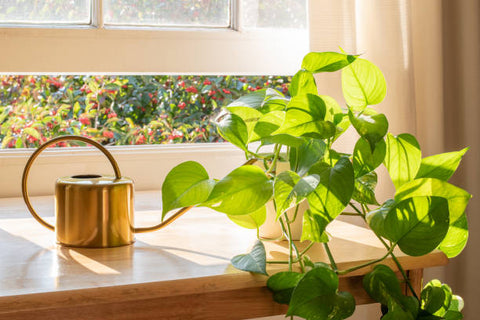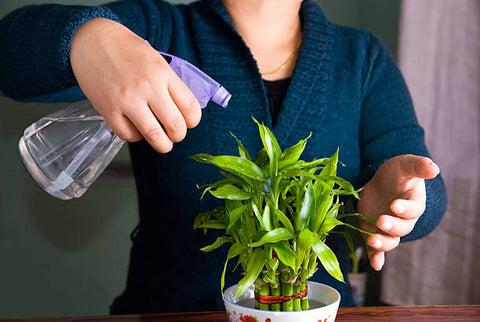
Top 15 Indoor Plants for Low Light
Fresh greenery truly infuses fresh life into a space. Sometimes you wish to add colour and greenery to the room if you live in an apartment or work in an office, but if your home lacks natural light or you're a novice plant caretaker worried about keeping things alive, don't freak out. Be at ease! You can still raise and maintain indoor plants even if your house lacks large, bright window where the sunlight pours in! In reality, a wide variety of plants can survive in low light!

It's crucial to understand that low light doesn't necessarily imply no light. In really gloomy spaces or during the coldest winter days, grow lights can add extra light. Many of them can even function just fine with sporadic table lamp illumination. Another thing to keep in mind is that plants in low light environments often do not require as much watering as those in high light environments.

Are you looking for the greatest indoor low-light plants that can survive in a dark room of your house?
Consider the following indoor low-light plants that are surprisingly simple to maintain and some even flourish in more shaded areas.
ZZ Plant
The ZZ plant is a low-maintenance indoor plant that potentially can thrive even in the absence of direct sunshine. Thus, you can find it in a lot of offices without windows. However, bright, indirect light benefits the plant the most. It can withstand dry circumstances as well, making it perfect for regular travellers. The ZZ plant has gorgeous leaves that are glossy, dark green, and grow erect, slightly arched stems

Snake Plant
Some of the greatest low-light indoor plants you can grow are Sansevieria species. They have an eye-catching appeal and requires very little upkeep. This mother-in-law's tongue or snake plant is a remarkably resilient plant that can survive for many years. It can withstand quite shady situations but prefers to thrive in partial shade. Note that animals can't handle it. Also, be careful not to overwater it, particularly if it is not exposed to sunlight, which dries out the soil. Overwatering can destroy a plant by causing root rot.
Pothos
Pothos can flourish in environments where hardly any other plants can, such as ones with very little light and nearly no water. Its appealing, robust, and simple-to-grow vines with heart-shaped leaves that are smooth, leathery, and easy to grow have made it one of the most well-liked indoor plants.
To keep the vines from becoming tangled, take sure to loosen and brush them occasionally. Additionally, because it is harmful, keep pets away from this plant.
Spider Plant
One of the most adaptive and simple-to-grow indoor plants is the spider plant. Its spider-like offshoots, known as spiderettes, which hang downward from the parent plant like spiders on a web, are the reason for its common name. In pots or baskets, spider plants can be cultivated as trailing or hanging plants. Even in less-than-ideal lighting settings, such as artificial light, they can persist for a very long time. Water the soil frequently to keep it from drying out.
Lucky Bamboo
Lucky bamboo plants can be seen in many homes and offices and can be grown in soil or water. Lucky bamboo plants are a crucial component of feng shui practise and are believed to bring luck and fortune, especially if they were given to you as a present. They are well-known for being almost invincible, which also helps. Although lucky bamboo prefers some light, it may survive in environments with almost complete shadow. Just be sure they're not close to windows or other poorly ventilated sections of your house. Additionally, keep them away from pets as they do possess poisonous elements.
Chinese Evergreen
The Chinese evergreen has round, glossy green leaves. These evergreens are great low-light indoor plants since they thrive in shadow. Keep them away from direct sunshine, which can damage the leaves. A variegated variety will require strong, indirect light to provide the best colour if you are cultivating one. However, all species may endure in shaded areas. This plant should not be used around pets because it is poisonous.

Philodendron
Due to their low maintenance requirements and capacity to give a room a jungle-like feel with their long, green tendrils, philodendrons are common houseplants. To keep the vines looking their best, make sure to dust them frequently. A window that lets in bright yet filtered sunlight is ideal indoors for lighting. Although some plants may survive in low-light conditions, their stems may develop leggy and their foliage may become scant. Because philodendrons are hazardous, keep pets away from them.
Prayer Plant
The prayer plant is a little tropical plant with lovely tricolored leaves that grows slowly. If you give it warmth and humidity, it grows well indoors. Although they can tolerate dim lighting well, these plants can be burned by direct sunlight on their foliage.

Monstera
Add Monstera to enhance your living area into a tropical resort. Monstera, often known as the Swiss cheese plant, has broad, leathery, green leaves with noticeable holes. These plants typically thrive in bright, indirect light indoors and grow naturally in shaded environments. The leaves might be burned by too much light. Pets should avoid these plants. It is even possible to repot a little Monstera into a hanging basket. Simply cut back the vining branches to keep the plant tidy. When the soil on a Monstera plant seems dry to the touch, water it. During the spring and summer, fertilise Monstera once a month.
Dracaena
Any room in your house will have an impression of luxury thanks to dracaenas. The Dracaena genus includes the dragon tree, which can grow in shade. It is also incredibly hardy and relatively simple to maintain. The ideal window will have bright, indirect lighting. Lower light levels won't kill it, but they can cause its leaves to become smaller than usual. As soon as you see any fading leaves, take them out to maintain it looking its best.

Peace Lily
The easiest way to sum up peace lily is to say that it is simple and lovely. This low-light houseplant produces long, graceful stems covered in pure white flower spikes. Even when the plants aren't in flower, peace lilies have lovely glossy green leaves.
They do require a lot of water, else the foliage would wilt. Watering, however, frequently revives withered foliage. Place these shade-loving plants where they will get indirect light. Additionally, because they are harmful, keep them away from pets.
Peperomia
Peperomia, which only grows 4–10 inches tall and has a broad variety of diverse leaf forms and colours, is ideal for terrariums or dish gardens. Because it is a native of rain forests and has minimal insect or disease concerns, it prefers to live in an area with high humidity levels.
English ivy
If you want to lush up a plain room, English ivy's trailing foliage is ideal for a hanging basket or urn. English ivy grows best in low light and has a wide range of leaf colours and forms. It's actually the ideal plant for a cold, north-facing windowsill. English ivy can also be trained to grow in a number of topiary shapes. Spider mites can be a problem with English ivy, so spray the plants frequently to keep them from colonising.

Anthurium
In the gloomy winter months, Anthurium's striking red, pink, orange, white, or purple blossoms are a wonderful treat. It's crucial to maintain a small moisture level in the soil at all times because these tropical beauties dislike excessively dry or wet soils. Although flowering may be inhibited in darker environments, anthurium blooms best in bright, indirect light. The plants' heart-shaped, bright green leaves, however, continue the colour display even when they are not in bloom.
Cast Iron Plant
This houseplant really does live up to its name. Aspidistra elatior, a cast-iron plant, thrives in darkness and requires just sporadic watering to live contentedly. This tough plant also spreads slowly, so it hardly ever needs to be replanted. There is a variegated variety of cast iron plant, although it can be hard to obtain, and it has narrow, dark green leaves.

Finally, you'll be able to incorporate some green into places you never imagined feasible, like a dark corner of the room. Popular kinds including pothos, dragon plants, succulents, and many others are ready to expand your world and show you how to incorporate plants into your aesthetic in easier, more adaptable ways. Furthermore, if you play your cards well, plants will last a lifetime, making them more cost-effective than buying trendy decor.
How to Take Care of Indoor Plants in Low Light?
It might be discouraging when the plants you can buy depend on your lighting situation, even if certain houseplants do flourish in dimmer environments. A few clever design choices can make all the difference in converting a dark, plant-less space into a useful one.
Magical mirrors
Mirrors can be angled to reflect light, which not only expands a room's perception of space and adds aesthetic appeal, but also helps illuminate dark areas that would otherwise be dark and dim.
Considering LED Lighting
LED lights, which are low-heat and energy-efficient, can be quite successful at promoting the growth of your plants (use blue light for foliage and red for flowering plants)

Make use of hanging planters
Lacking room for additional lighting or floor space? The ability to have more specialised lighting options is an extra benefit for plants small enough to fit in a hanging planter. As long as your ceiling is solid, you should be fine.
FAQ’s
Which houseplants can live without sunlight?
One of the greatest indoor plants for dark areas is the pothos, often known as Devil's Ivy. It is incredibly hardy. The pothos, a plant that doesn't require sunlight to develop, can also reduce the amount of carbon monoxide in the air.
Do plants thrive in dark environments?
Although you can grow plants in low-light or pitch-black environments, you still need SOME sunshine. Chinese evergreen and cast iron plants, for example, may even withstand brief periods of darkness, but if they don't receive any natural or artificial light, they will eventually perish.
How do you maintain plants in a space without windows?
Light up the room!
The typical illumination in the room can also meet the needs of the plant for light, in addition to the grow lights. The plant should be kept close to a light source or placed near lights.
Without sunlight, how can indoor plants survive?
Without sunshine, LED lights are the most adaptable and safest option for growing plants. They emit very little heat, and unlike fluorescent or HPS lights, they are much simpler to modify the colour of the light they emit.




















Leave a comment